#renewableenergysources
Explore tagged Tumblr posts
Text

A great article to read and understand why the need for energy resilience has never been more urgent.
I really enjoyed while reading this article.
Link: tinyurl.com/yedzzt8s
2 notes
·
View notes
Text
Australia’s Booming Renewable Energy Sector: Powering the Future

Australia is at the forefront of a green revolution, with its renewable energy sector undergoing an unprecedented transformation. Blessed with abundant natural resources and a favourable climate, the country is uniquely positioned to lead the charge towards a sustainable energy future. This growth is not just a response to environmental challenges but a testament to the nation’s commitment to innovation, economic development, and global leadership.
Government Policies and Renewable Energy Targets
The Australian government has played a pivotal role in driving the renewable energy sector through progressive policies and ambitious targets. The Australian renewable energy target (RET) aims to ensure that a significant portion of the nation’s electricity comes from renewable sources. By setting clear objectives and providing financial incentives, the government has created a conducive environment for investment and innovation in clean energy.
Economic Benefits
Renewable energy is not only environmentally friendly but also economically advantageous. The decreasing costs of solar panels, wind turbines, and battery storage have made renewable energy highly competitive compared to traditional fossil fuels. Moreover, the growth of Australian renewable energy companies has fostered job creation and attracted significant domestic and international investment. From construction to research and development, the sector has opened up new economic avenues.
Environmental Benefits
Transitioning to renewable energy helps Australia reduce its dependence on fossil fuels, which are major contributors to greenhouse gas emissions. This shift aligns with global efforts to combat climate change while improving air quality and preserving natural habitats. By prioritizing clean energy, Australia is positioning itself as a key player in global sustainability initiatives.
Australia’s booming renewable energy sector highlights its commitment to a sustainable future. Through robust government policies, innovative technologies, and collaborative efforts, the nation is on track to achieve its renewable energy targets. As global demand for clean energy grows, Australia stands out as a beacon of progress, demonstrating the transformative power of renewable energy in shaping a better tomorrow.
Read More: Australia’s Booming Renewable Energy Sector: Powering the Future
0 notes
Text
Australia’s Booming Renewable Energy Sector: Powering the Future

Australia is at the forefront of a green revolution, with its renewable energy sector undergoing an unprecedented transformation. Blessed with abundant natural resources and a favourable climate, the country is uniquely positioned to lead the charge towards a sustainable energy future. This growth is not just a response to environmental challenges but a testament to the nation’s commitment to innovation, economic development, and global leadership.
Government Policies and Renewable Energy Targets
The Australian government has played a pivotal role in driving the renewable energy sector through progressive policies and ambitious targets. The Australian renewable energy target (RET) aims to ensure that a significant portion of the nation’s electricity comes from renewable sources. By setting clear objectives and providing financial incentives, the government has created a conducive environment for investment and innovation in clean energy.
Economic Benefits
Renewable energy is not only environmentally friendly but also economically advantageous. The decreasing costs of solar panels, wind turbines, and battery storage have made renewable energy highly competitive compared to traditional fossil fuels. Moreover, the growth of Australian renewable energy companies has fostered job creation and attracted significant domestic and international investment. From construction to research and development, the sector has opened up new economic avenues.
Environmental Benefits
Transitioning to renewable energy helps Australia reduce its dependence on fossil fuels, which are major contributors to greenhouse gas emissions. This shift aligns with global efforts to combat climate change while improving air quality and preserving natural habitats. By prioritizing clean energy, Australia is positioning itself as a key player in global sustainability initiatives.
Australia’s booming renewable energy sector highlights its commitment to a sustainable future. Through robust government policies, innovative technologies, and collaborative efforts, the nation is on track to achieve its renewable energy targets. As global demand for clean energy grows, Australia stands out as a beacon of progress, demonstrating the transformative power of renewable energy in shaping a better tomorrow.
Read More: Australia’s Booming Renewable Energy Sector: Powering the Future
0 notes
Text
youtube
The global market for renewable energy certificates is projected to grow by USD 186.5 billion by 2032, with a compound annual growth rate (CAGR) of 28% from 2024 to 2032. In 2023, North America dominated the market, holding over 42% of the share. According to the International Renewable Energy Agency (IRENA), the global capacity of renewable energy sources reached 2,799 GW in 2020, representing 72% of net additions to global power capacity that year. In Europe, the European Commission reported that the total installed capacity of renewable energy sources in the EU reached 388 GW in 2020, contributing to 38% of the region's electricity generation.
#Renewableenergycertificates#renewableenergy#renewableenergysystems#energy#renewableenergysources#renewableenergysolutions#marketresearchreport#marketresearch#acumenresearchandconsulting#marketresearchcompany#news#Youtube
0 notes
Text

United States Battery Market size by value at USD 16.2 billion in 2023. During the forecast period between 2024 and 2030, BlueWeave expects United States Battery Market size to expand at a CAGR of 12.90% reaching a value of USD 39.5 billion by 2030. The Battery Market in United States is propelled by the escalating demand across diverse sectors, including electric vehicles, stationary energy storage systems, and aviation. The global shift towards sustainable transportation, underpinned by stringent emission regulations and government incentives, has accelerated the adoption of EVs, thereby driving demand for high-performance batteries. However, the market has its challenges, as environmental concerns associated with battery production have prompted regulatory scrutiny. Technological advancements, such as the development of solid-state batteries, are also pivotal in shaping the market. Beyond transportation and stationary storage, advanced batteries are finding applications in portable electronics and critical infrastructure. In conclusion, the market for advanced batteries is poised for continued growth, driven by technological innovation, regulatory oversight, and increasing demand across various industries. As the world transitions towards a more sustainable and electrified future, the role of batteries in enabling clean energy solutions will become increasingly critical.
Sample Request @ https://www.blueweaveconsulting.com/report/united-states-battery-market/report-sample
Opportunity - Advancements in Battery Technology
Advancements in battery technology, particularly the emergence of Nuclear Diamond Batteries (NDBs), present significant growth opportunities for the United States Battery Market. NDBs are a groundbreaking energy generation and storage solution that harnesses the energy from radioactive decay of nuclear waste, offering a revolutionary alternative to traditional batteries. Their unique properties, including compactness, modularity, cost-effectiveness, and scalability from chipsets to industrial applications, position them as a formidable competitor in the energy landscape. Moreover, government initiatives, such as tax credits and funding for electric vehicles and battery innovations, have bolstered the adoption of clean energy technologies, driving market growth.
#Blueweave#Consulting#marketreserch#marketforecast#EnergyStorageSystems#ElectricVehicles#RenewableEnergySources#SustainableEnergy#BatteryInnovation#CleanEnergy#GreenTechnology#MarketResearch
0 notes
Text
Reversing Global Warming: Actions and Impacts
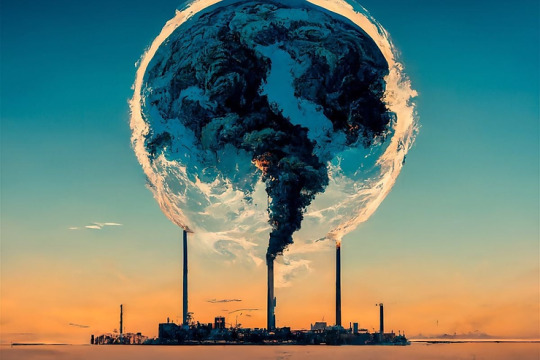
Reversing the effects of global warming necessitates a blend of large-scale initiatives and everyday practices. This article delves into the effectiveness of diverse strategies, such as increasing tree plantations, adjusting AC temperatures, embracing electric vehicles, and minimizing food waste, to highlight their significant environmental impacts.
Read Full Article: https://www.globallaunchbase.com/post/reversing-global-warming-actions-and-impacts
Written By: Jagriti Shahi Key Contributor: Anubha Chicki
#ReversingGlobalWarming hashtag#ClimateChangeSolutions#hashtag#ReduceCarbonFootprint hashtag#RenewableEnergySources#SustainablePractices hashtag#EnvironmentalConservation#GreenhouseGasReduction hashtag#ClimateActionInitiatives#CarbonNeutralStrategies hashtag#EcoFriendlyTechnologies#ClimateResilience hashtag#SustainableLivingTips hashtag#GlobalWarmingMitigation#GreenEnergyAdoption hashtag#ClimateChangeImpactReduction#SustainableDevelopmentGoals hashtag#ClimateCrisisSolutions#EnvironmentalSustainability hashtag#ClimateChangeAdaptation#CarbonOffsetPrograms
0 notes
Link
Extinct ‘mountain jewel’ plant resurrected in the wild in secret location
#resurrected#Plant#wild#Secret#jewel#Homesciencekits#mountain#location#Scienceinpopculture#extinct#Renewableenergysources#Scienceeducationtrends
0 notes
Text
Is America's Energy Policy Putting Us in the Dark? The Risk of Power Outages and Unstable Energy Supply #carbonemissions #coalandnuclearplants #energysecurity #energysupply #fossilfuels #gridvulnerability #intermittentrenewableenergy #poweroutages #renewableenergysources #USenergypolicy
#Politics#carbonemissions#coalandnuclearplants#energysecurity#energysupply#fossilfuels#gridvulnerability#intermittentrenewableenergy#poweroutages#renewableenergysources#USenergypolicy
0 notes
Text
Sigma Lithium: Profitable and Sustainable Future in Lithium Mining #averagesalesprice #CEOAnaCabralGardner #commitmenttosustainability #environmentalresponsibility #financialperformance #grossprofit #indigenouspeoples #lithiummarket #lithiumminingcompany #netprofitmargin #partnershipswithlocalcommunities #productioncapacityexpansion #productionvolume #promisingfuture #provenandprobablereserves #renewableenergysources #revenue #sharesrose #SigmaLithium #sustainability #waterconsumption
#Business#averagesalesprice#CEOAnaCabralGardner#commitmenttosustainability#environmentalresponsibility#financialperformance#grossprofit#indigenouspeoples#lithiummarket#lithiumminingcompany#netprofitmargin#partnershipswithlocalcommunities#productioncapacityexpansion#productionvolume#promisingfuture#provenandprobablereserves#renewableenergysources#revenue#sharesrose#SigmaLithium#sustainability#waterconsumption
0 notes
Text
King Charles III Green Apprenticeships Unveiled

A New Era for UK's Young Eco-Leaders
Introduction to a Royal Initiative In an ambitious move that aligns with the United Kingdom's growing focus on sustainability, His Majesty King Charles III has introduced an innovative series of Green Apprenticeships. This initiative is not only a testament to His Majesty's lifelong commitment to environmental stewardship but also a beacon of hope for the younger UK demographic, particularly those aged 18-30, who are eager to contribute to a greener and more sustainable future. The Vision of a Green Monarch His Majesty's vision transcends traditional royal duties, embedding a deep-rooted concern for the planet within the very fabric of his reign. The launch of the Green Apprenticeships, marked with the Coronation emblem, is a celebration of this vision. Furthermore, it's a call to action for the UK's youth to step up and be at the forefront of the environmental movement. Nuclear Restoration Services (NRS), a leader in decommissioning nuclear sites, has embraced this initiative, highlighting its commitment to a sustainable future by introducing a corporate responsibility and sustainability apprentice position. A Step Towards Sustainability Moreover, the apprenticeships cover a wide spectrum of expertise, from Level 2 entry-level operative roles to Level 6 degree apprenticeships in engineering. Each position, including the highlighted Level 4 qualification sustainability apprenticeship at NRS's Bristol Hub, is designed to equip the UK's future workforce with the knowledge and skills needed to drive the sustainability agenda forward. Industry and Royal Synergy The synergy between industry experts and royal visionaries underscores the importance of collaborative efforts in addressing global environmental challenges. Emma Reynolds, NRS Director of Corporate Affairs, eloquently captures the essence of this partnership, stating that the Green Apprenticeships signify a bold step towards nurturing a generation of eco-conscious leaders. This initiative not only honors His Majesty's environmental ethos but also solidifies the UK's position as a leader in sustainable development. A Call to Action for the UK's Youth The introduction of King Charles III's Green Apprenticeships is more than just an educational opportunity; it's a clarion call for the younger generation in the UK to become stewards of the earth. With a variety of apprenticeships available, there's a pathway for every aspiring eco-leader to contribute to a more sustainable and environmentally responsible UK. As we embrace this new era of green apprenticeships, the promise of a sustainable future becomes ever more attainable, cementing the legacy of His Majesty's reign as one of environmental stewardship and hope for future generations.
Summary
In embracing these opportunities, the UK's youth are not just pursuing a career; they are stepping into roles that will define the environmental legacy of a nation. The initiative encourages active participation in shaping a sustainable future, making each apprentice not only a beneficiary of royal patronage but also a crucial player in the global movement towards environmental sustainability. This is a unique chance to make a significant impact, aligning personal and professional growth with the broader objectives of ecological conservation and sustainability leadership. Check out the other opportunities here: Apprentice Careers - Energus. Sources: THX News & Nuclear Restoration Services. Read the full article
#CorporateSocialResponsibility#eco-consciousleaders#environmentalresponsibilityUK#greenapprenticeshipsUK#KingCharlesIIIGreenApprenticeships#Level4qualificationsustainability#RenewableEnergySources#sustainabilityagendaUK#sustainabilityapprenticeshipopportunities#sustainablefutureUK
0 notes
Text
Harnessing the Sun: India's Remarkable Solar Power Project

India, known for its diverse landscape and rapid economic growth, has embarked on an ambitious journey to tap into the abundant energy resource provided by the sun. With an aim to reduce carbon emissions, increase energy security, and foster sustainable development, the Indian government has undertaken an extensive solar power project. This article explores the remarkable strides India has made in the field of solar energy, highlighting the country's commitment to renewable resources and its positive impact on the environment and economy.
The Solar Power Revolution in India:
In recent years, India has witnessed a solar power revolution, transforming its energy landscape. The government's aggressive push towards renewable energy sources, particularly solar power, has resulted in impressive growth and achievements. The Jawaharlal Nehru National Solar Mission (JNNSM), launched in 2010, set an ambitious target of deploying 20 gigawatts (GW) of solar power by 2022. However, India not only achieved this target but surpassed it, reaching a capacity of 40 GW by the end of 2022, making it one of the largest solar markets in the world.
Key Projects and Initiatives:
Several key projects and initiatives have played a vital role in India's solar power revolution. The country boasts the world's largest solar park, the Pavagada Solar Park in Karnataka, spanning over 13,000 acres and generating 2 GW of clean energy. Furthermore, the Rewa Ultra Mega Solar Park in Madhya Pradesh, with a capacity of 750 megawatts (MW), stands as one of the largest single-site solar parks globally.
Additionally, the government has introduced favorable policies and incentives to attract investment in the solar sector. The introduction of solar auctions and long-term power purchase agreements (PPAs) have significantly contributed to the growth of solar power projects. The "Make in India" campaign has also encouraged domestic manufacturing of solar equipment, reducing dependence on imports and promoting job creation within the country.
Economic and Environmental Benefits:
India's solar power project has brought about numerous economic and environmental benefits. Firstly, the growth of the solar sector has generated employment opportunities, particularly in manufacturing, installation, and maintenance of solar panels and equipment. This has contributed to the development of a skilled workforce and an overall boost to the economy.
Moreover, the increased reliance on solar power has reduced the country's carbon footprint, mitigating the impact of climate change. The shift towards cleaner energy sources has led to a substantial decrease in greenhouse gas emissions, improving air quality and public health. Additionally, the solar power project has reduced India's dependence on fossil fuel imports, enhancing energy security and reducing the vulnerability to price fluctuations in the global market.
Challenges and the Way Forward:
While India has made remarkable progress in the solar power sector, certain challenges remain. The intermittency of solar power generation and the need for energy storage solutions pose a significant hurdle. Developing efficient energy storage technologies will ensure a stable and consistent power supply, even during periods of low sunlight.
Additionally, the integration of solar power into the existing grid infrastructure requires careful planning and investment in grid modernization. Strengthening the transmission and distribution infrastructure will facilitate the smooth integration of solar power into the grid, ensuring reliable electricity supply.
Conclusion:
India's solar power project stands as a shining example of the country's commitment to renewable energy and sustainable development. By surpassing its solar power targets and embracing solar technologies, India has transformed its energy landscape and made significant strides towards a greener future. The economic and environmental benefits, coupled with the country's emphasis on job creation and energy security, highlight the potential of solar power to drive India's sustainable growth. With continued investments and technological advancements, India's solar power project is set to play a crucial role in achieving a cleaner and more sustainable energy ecosystem.
1 note
·
View note
Link
#cleanenergyalternatives#climatechangesolutions#EnvironmentalImpact#RenewableEnergySources#renewablevsnon-renewable#sustainablefuture
0 notes
Text
What IoT Can Do For The Solar Sector?
Utilities Business Review: Solar is the globe's fastest-growing renewable power source, with global capacity growing by an average of 40% annually.

0 notes
Text
youtube
Acumen Research and Consulting forecasts that the global renewable energy market will reach approximately USD 1,500 billion by 2027, growing at a compound annual growth rate (CAGR) of around 6% from 2020 to 2027. Renewable electricity is generated from naturally replenishing sources such as water, solar energy, ocean currents, wind, and geothermal heat. This form of energy is commonly utilized for electricity generation, heating and cooling fluids, transportation, and rural energy needs.
#renewableenergy#renewableenergysystems#energy#renewableenergysources#renewableenergysolutions#marketresearchreport#marketresearch#acumenresearchandconsulting#marketresearchcompany#news#Youtube
0 notes
Text
China has emerged as a global leader in renewable energy. It makes significant strides in harnessing clean and sustainable sources of power. With its vast population and rapid economic growth, China recognizes the importance of transitioning to renewable energy to meet its energy needs while reducing carbon emissions.
Please visit our website for more information: https://zbotek.com/ or email us at [email protected].
0 notes
Text
The Role of Renewables in Decarbonisation
Written By: Jagriti Shahi
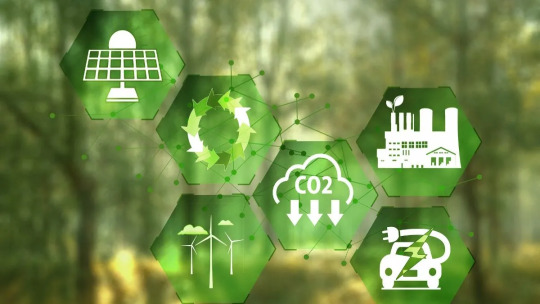
Introduction:
As the world grapples with the urgent need to mitigate climate change, the imperative for decarbonization has become increasingly apparent. At the forefront of this global effort are renewable energy sources, which play a pivotal role in reducing greenhouse gas emissions and transitioning towards a sustainable energy future. In this article, we delve into the multifaceted role of renewables in decarbonization, exploring their benefits, challenges, and the path forward.

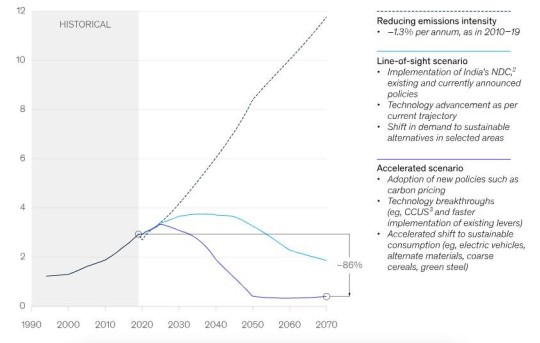
Figure: An overview and possible decarbonisation pathways for India - Source: Mckinsey & Company
The Rise of Renewables:
Renewable energy sources, such as solar, wind, hydro, and biomass, have witnessed remarkable growth and technological advancements in recent years. This surge can be attributed to several factors, including declining costs, policy support, and heightened environmental awareness. Notably, renewables have emerged as competitive alternatives to fossil fuels, offering cleaner, more sustainable energy solutions.
Decarbonization Imperative:
Decarbonization, the process of reducing carbon dioxide and other greenhouse gas emissions, is crucial for mitigating climate change and achieving global climate targets, such as those outlined in the Paris Agreement. The energy sector, being a significant contributor to greenhouse gas emissions, holds immense potential for decarbonization through the adoption of renewable energy technologies.
The Role of Renewables:
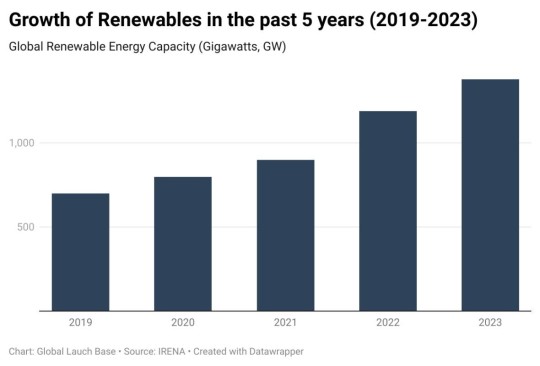
Figure: Growth of Renewables in the past 5 years
Renewable energy sources play a multifaceted role in decarbonization across various sectors:
Power Generation: Renewables are instrumental in decarbonizing electricity generation, displacing carbon-intensive sources like coal and natural gas. The scalability and versatility of renewables enable the deployment of clean energy infrastructure on a global scale, driving the transition towards low-carbon electricity grids.
Transportation: The electrification of transportation, facilitated by renewable energy, is pivotal for reducing emissions from the transport sector. Electric vehicles (EVs) powered by renewable electricity offer a sustainable alternative to conventional internal combustion engine vehicles, thereby curbing emissions and improving air quality.
Heating and Cooling: Renewable energy technologies, such as solar thermal and geothermal systems, hold promise for decarbonizing heating and cooling in buildings and industrial processes. By harnessing renewable heat sources, it is possible to reduce reliance on fossil fuels for heating purposes, contributing to overall emissions reduction.
Industry and Agriculture: Renewable energy integration in industrial processes and agriculture can mitigate emissions associated with manufacturing, processing, and agricultural activities. From solar-powered factories to bioenergy production from agricultural waste, renewables offer innovative solutions for decarbonizing these sectors.
Renewables in Low Carbon Construction:

Figure: Primary Energy Mix,% Source: Mckinsey & Company
Low carbon construction encompasses practices and technologies aimed at minimizing carbon emissions associated with building materials, construction processes, and building operation. Renewable energy plays a crucial role in this context through several avenues:
Renewable Energy Integration: Incorporating renewable energy systems, such as solar panels and wind turbines, into building designs reduces reliance on carbon-intensive grid electricity for powering homes and commercial buildings. Additionally, utilizing renewable energy for heating and cooling purposes in buildings mitigates emissions associated with traditional heating fuels like natural gas.
Sustainable Materials: Renewable resources can be utilized to produce sustainable building materials, such as bamboo, timber, and recycled materials. These materials not only have lower embodied carbon compared to traditional counterparts but also contribute to biodiversity conservation and sustainable land management.
Energy Efficiency: Renewable energy complements energy-efficient building design and technologies, enhancing overall energy performance and reducing operational carbon emissions. Integrating renewables with energy-efficient measures, such as insulation, efficient lighting, and smart building controls, maximizes energy savings and minimizes environmental impact.
Carbon Capture, Use & Storage (CCUS):
CCUS technologies are instrumental in capturing carbon dioxide emissions from industrial processes and power generation facilities, preventing their release into the atmosphere. The captured CO2 can then be utilized in various applications or stored underground, effectively reducing net emissions. Renewables play a vital role in CCUS through the following mechanisms:
Powering CCUS Facilities: Renewable energy sources provide low-carbon electricity to power CCUS facilities, reducing the carbon footprint of the capture and storage process. By utilizing renewable electricity instead of fossil fuels, CCUS operations can achieve significant emissions reductions while ensuring sustainable operation.
Renewable Hydrogen Production: Renewable energy, particularly solar and wind power, can be utilized to produce renewable hydrogen through electrolysis. This renewable hydrogen serves as a clean energy carrier for industrial processes and transportation, enabling decarbonization in sectors where direct electrification may be challenging.
Carbon Utilization: Renewable energy can facilitate carbon utilization technologies, where captured CO2 is converted into valuable products such as synthetic fuels, chemicals, and building materials. By coupling CCUS with renewable energy-driven conversion processes, carbon emissions are not only mitigated but also utilized in a circular and sustainable manner.
Challenges and Opportunities:
While the integration of renewables with low carbon construction and CCUS offers significant potential for decarbonization, several challenges must be addressed. These include technological limitations, cost competitiveness, policy frameworks, and public acceptance. Overcoming these challenges requires collaborative efforts from governments, industry stakeholders, and research institutions to drive innovation, scale deployment, and create supportive regulatory environments.
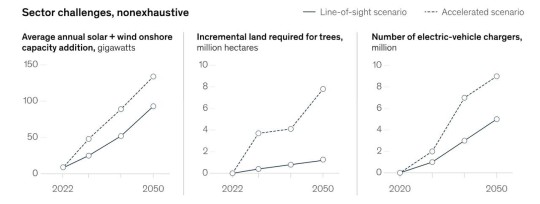
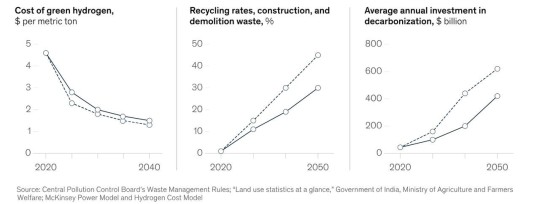
Figure: Sector Challenges, Source: Mckinsey & Company
The Path Forward:
To harness the synergies between renewables, low carbon construction, and CCUS effectively, concerted action is needed at the global, national, and local levels. This includes:
Setting ambitious decarbonization targets and policies that incentivize the adoption of renewables, promote low carbon construction practices, and support CCUS deployment.
Investing in research, development, and innovation to advance renewable energy technologies, low carbon materials, and CCUS solutions.
Fostering collaboration among governments, businesses, and communities to accelerate the transition to a low-carbon economy and achieve net-zero emissions.
Conclusion:
Renewable energy, coupled with innovative approaches such as low carbon construction and CCUS, holds immense promise in driving decarbonization across multiple sectors. By leveraging the synergies between these strategies, we can mitigate carbon emissions, enhance resilience to climate change, and pave the way for a sustainable future. Now is the time to embrace renewables as catalysts for transformative change and forge a path towards a low-carbon society.
#Renewables hashtag#Decarbonisation hashtag#SustainableEnergy hashtag#CleanEnergy#hashtag#RenewableEnergySources hashtag#SolarPower hashtag#WindEnergy hashtag#ClimateAction#GreenEnergy hashtag#CarbonReduction hashtag#EnergyTransition hashtag#EnvironmentalSustainability hashtag#RenewablePowerGeneration#LowCarbonFuture hashtag#EnergyInnovation
0 notes